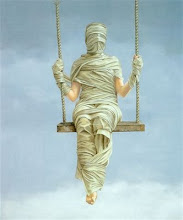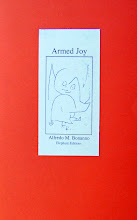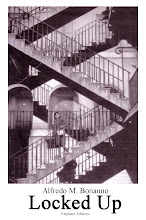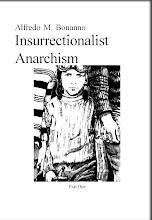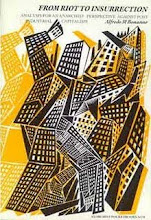introduction
.
We have built this book together, over the past few years, piece by piece, with what we have dreamed, thought and done. Now I am
consigning it to the coldness of paper: a reflex of what I would have liked with the sense and with reason.
A poor thing however it is. Grammatical order rinnega the need for liberation and ribadisce the segragative logic of the text.
Bearing that in mind I want to suggest a reading together. For editoriasl reasons the work, while maintaining its organicity, has been
divided into three separate books: The Illogical Revolution, followed by Theory and Practice of Insurrection, then Who is Afraid of the
Revolution?
The Illogical Revolution centres on the problem of contradiction. We are continually weaving a web that somebody (including we
ourselves) unsew immediately afterwards. Ambivalence in what we are doing and ambivalence of the reality in which we are operating.
Only a few of us are not able to act, it is not possible to grow to infinity. It is all very well to change but it is then necessary to come to
a halt. No one survives for long with a knife between their teeth. To understand, but not let oneself become wrapped up in the funeral
sheet of theory. To know how to act, but also to know how to wait. To recognise one's own identity but not consider oneself the only
holders of the revolutionary flame. To criticise others, but not suffocate the attempts that are going in the right direct direction. To
recognise this direction without letting oneself be drawn in by adverse forces. In every reveloutionary one therefore perceives a negative
limit, a possible opening to the forces of recuperation. In the same way in every repressive project a defect and an approximation can be
individuated that allow for the next revolutionary development. In this perspective anarchism is never neutral. It must, from time to time,
riproporsi from the beginning. It cannot be taken for granted. One cannot say: it is the ideology di cui si suppone la fondatezza. The
analysis itself, in its extreme consequence, lo vanifica. It is precisely ideology that demonstrated it. But the whole demonstrative process
is desacrating. The result can also be an empty point, in that often the periphery of a discourse contributes to closing in a centre that is
lacking. We ourselves are not raccapezziamo with words. We betray them and they betray us. The knowledge we reach through analysis
si ritorce, at a certain point, on itself, becomes impossible knowledge. We turn around inside the object and can do nothing other than
turn backwards. We reconfirm in this way to the subject that which he not only supposed but knew with certainty.The novelty apportata
does not exist therefore in the unknown territories of the object - which remain such - but in the same process of knowledge. The
contradictions of this process are the vital experience of the subject, its only way of acting and do not in any way revoke the unicity and
individuality of the object.
Theory and practice of Insurrection develops the constructive work of the revolutionary, itas impact on the immediate. Organisation and
the relationship with the political forces are at the centre of this book. Who rebels? Why rebel? The minuzie of the detail carry nothing
really important if not the attempt as such. Irt is not the proposal in itself that resolves the immediate problem of the class struggle. It
can also be the most adequate possible but is still very far from reality. However it remains necessary. The effects of its action are very
disturbing. They always go beyond the limitation that dictated it. Woe to falling into the equivoco. The quantitive ghost is always around
the corner. Organisation is proletarian mass in movement which si aggrega, but is also the specific union of a few people around a project.
The two things do not exclude each other, rather they compliment each other. In the same way the quantitive proposal enters the
political agone but not in the perspective of growth to infinity. It stops with the immediate aim of aggregation, does not have specific
filters that tratengono for an indefinite period and therefore transform it into a party. The contrast with the usual political forms could not
be more strident. But it is precisely this violence to oneself that underlines the rebelistic component of the same quantitive aggregation, it
does not have specific filters that tratengono it . The percorso of an analysis, this time too, seem to girare a vuoto. Why gather if one
cannot proceed beyond that? And in the return of delusion the apparent vainness of the revolutionary event is reconfirmed. The
inconcludenza of the project si ribalta though in the value of the percorse, of what the relationship with other political forces had been, of
what will become of the single individuals linked together by the same experience.
THE CONTRADICTORY ELEMENT OF THE REVOLUTION
Quantitive comfort and the function of criticism
One of the most immediate and natural reactions to the difficulties of the class struggle is to place one's trust in the comfort of the
quantitive, of the immediately visible, of the objective comparison. No matter how we criticise it or try to push it away, we will never
succeed in completely eliminating such an instinct, which is typical of the shopkeeper.
We are pushed by fear of losing the identity of our action, of seeing ourselves drawn into a dimension that we consider to be purely
subjective, while all around us theretalk of accumulation and progress, perfectionment, immediate ends, concrete facts. We almost feel
the panic of utopia. And in the feat of l o s i n g the world we convince ourselves that the only solution is to link ourselves to it with the
chains of slavery.
To tell the truth we do possess sufficient clarity in our ideological universe, and when we feel sure enough of ourselves, when we do
not feel the earth caving in under our feet, we also discuss the critical perspectives in which this universe can and must develop or
change into. But when external events become chaotic and convulsed and social tension grows and there is abinding urgency for clarity,
then we put our faith in our universe as something salda and definitive, forgetting our good critical principlesand good intentions.
We turn into fearful, straying watch-dogs, we wind our long tails around any hypothesis that moves away from our sacrosanct fixed
ideas, and clutch on to it, and condemn without pity. We mummify ourselves, forgetting ourselves in a fixity of Greek tragedy: the
revolution becomes a project concluded in all its parts; our revolution, the anarchist revolution, leaves no room for discussion. Whoever is
not with us is against us.
Of course whoever is not with us is against us. We have taken a side, even though not a party. We have never spoken of a universal
brotherhood that cuts across classes. We are firmly convinced that people will become pacified by the revolutionary event only after a
long series of painful and bloody happenings, therefore the revolution is nothing other than the evolving, perhaps slowly, of this series of
events. But that doews not alter the fact that any project that starts from the discriminatory hypothesis 'whoever is not with us is
against us' is too net and artificial.
If it were not so, if it were really possible to start off from so much clarity of distinction, ours would be a splendid isolation, a tragic and
desolate isolation. Closed in the ivory tower of our anarchism we would see reality deformed frrom the distance which, for reasons of
ideological security, we would be obliged to put between ourselves and the rest of the revolutionary movement.
On the contrary, the aim of criticism is to shorten the distance - as far as is possible - from those forces which move in a revolutionary
direction, even although they are forces that present a project that is different to our own. And that is not with the aim of making
superficial alliances or difficult convergences that end up damaging our work as anarchists while they turn to the advantage of all the
other components of the revolutionary movement, but only to allow ourselves to reach a better comprehension of the objective conditions
of the revolutionary process.
Movement and process
The revolutionary process as a whole is derived from the different disporsi of the revolutionary movement concerning the level of the
class struggle. We therefore have that revolutionary process and class struggle are not synonymous: the latter includes social affairs in
the wider vision of conflictual relations between individuals within classes and between classes within society; the first includes the
authoritarian structures of the exploited and specific revolutionary structures in the narrow sense.
Considering, among other things, that each militant is at the same time a part of a structure of the revolutionary movement and also
finds himself living in a certain situation within the class clash, and also considering that it is not at all true that this difference does not
exist (as has been affirmed for too long) so the comrade is in the first place one exploited among other exploited; one finds that things
complicate themselves considerably.
Each individual within society pooaces themselves in relation to the different situations (individuals, ideas, structures, forms, etc)
ranging from the State to the spontaneous expressions of organisation (absenteeism, selfgovernment, sabotage, expropriation, renitence,
etc). This immense t e r r i t o r y of relations that constitutes s o c i a l s p a c e, is also the place of the class struggle. A significant
part of these relations - that which is most qualitatively prevalent and ends up characterising the rest - is made up of class relations. The
class clash being an event which develops not only in time but also in social space, we find we can speak of a l e v e l of the clash, and
that this level can be higher or lower according to whetherit is the exploited or the exploiting to have the upper hand, and that because
of the fact that we giove the clash clash a positive connotation, consider it a liberatory event. therefore its rising up, for us, corresponds
to a prevalere (not to a victory, but to a prevalere) of the initiatives and actions of the ewxploirted masses.
No matter how high the level of the clash might be, and therefore also in those objective conditions that we normally define r e v o l u t
i o n a r y it will never be possible to verify, in the whole of the initiatives and actioons coming from the exploited, such a homogenity as
to be wholly shared or rejected completely by a specific component of the revolutionary movement. It will always happen that the
exploited's same multiform capacity for expression, the heterogenity of their needs, the creativity that scaturisce from initiatives that
consent an expression that was once impossible, will make the r e a l i t y of the class clash something very different to the m o d e l s of
intervention of the revolutionary movement.
But the lastter, precisely because it is revolutionary, will never be something t o t a l l y different to that reality. It will always be
something p a r t i a l l y different, that is something that feels the influx of that reality, absorbs its conditioning, motivations and
indications, to transform them into models of intervention on reality itself with the aim of modifying it and addressing it towards considered
valid a priori on the basis of an analysis with a strong ideological conditioning.
The i n t e r a c t i o n between revolutionary movement and the level of the class clash, in that disporse of the first towards the
second, and the second towards the first, in practice in the r e v o l u t i o n a r y p r o c e s s determines reciprocal influences.
Through its models of intervention, the revolutionary process tries, as we have said, to modify the level of the clash, therefore to
advance in social space in such a way that one gains more and more field of movement as it is subtracted from the forcees of repression;
but the conditions of the clash itself have an influence in turn on the revolutionary movement and condition its activity, accentuating its
differentiations and underlining the various ideologicAL DIFFERENCES.
tHE AUTHORITARIAN COMPONENTS OF THE REVOLUTIONARY MOVEMENT
It is very important to understand that the authoritarian components of the revolutionary movement (marxist-leninist, stalinist, and the
more or less a u t o n o m o u s shades), receive a real i n v e s t i t u r e from the level of the clash. The lower this is, the more these
components, from the most orthodox stalinism to the most complicated forms of marxism that are looking for an improbable marriagewith
autonomy, receive credibility and supply ideological direction. The point of reference is the concept of the party: a low level of the clash
makes recourse to the party seem logical and, per un altro verso, the party contributes to keeping the level of the clash low. Things
cannot be otherwise. The party tends to put itself us as r e s e v o i r of the movement's experiences, while it is nothing but a point of
reference for the most backward conceptions of the movement itself, conceptions linked to delegating and to a guide, to centralisation,
(more or less democratic), to permanent and professional structures. The party always acts as d e c e l e r a t o r of the revolutionary
process. Transporting analyses from the centre to the perifery it ends up making the seeds of waiting penetrate the base of the
movement, the accumulability of experiences, "it is not the right moment", hesitation, p o l i t i c s , and quantitive growth. But that part
of the movement that puts such a decelaration of the process into action is not for that foreign to the process itself; it cannot be
considered something imposed from the outside and therefore a b s o l u t e l y counter-revolutionary. Actions that really come from the
outside of the revolutionary movement are those promoted by the class enemy, from the present day holder of the relations of production,
from the manipulator of privileges of the p r e s e n t, from the p r e s e n t programmer of the ideologies of power. Such actions do not
affect directly the revolutionary movement, in the case of the contrary even the reactionary forces would make up part of the
revolutionary movement and the s p e c i f i t y of the latter would be lost. The forces of reaction (in the first place the State) participate
in the social clash not in the revolutioonary movement, but are in relation to the latter through their participation in the alterne vicende of
the former.
The negative effect (of declaration) that the authoritarian components of the revolutionary movement (armed parties in the first place)
have on the level of the class clash is a consequence of the i n t e r a c t i o n between it and the level of the clash. A certain level
produces effects that favour their growth, in their turn these components contribute to lowering the level leading to situations that turn
out to be still more favourable to declaration and therefore to the extension of the authoritarian component itself.THE SPECTACULAR
LEVEL OF THE CLASH
We must understand what we mean about this phenomenon and the real weight of its individual instances. So we therefore have it clear
that the authoritarian components (in their possible partitic expressions) are not something that has fallen from the sky, nor are they the
product of the decision of a summit of professional revolutionaries. They are instead the result of a very complex inrteraction between
revolutionary movement as a whole (therefore not only the authoritarian components) and the level of the clash. We also have it clear
that the action carried out by these components tends to lower the level of the clash. Moreover: we can say that the action, the more it
tries to raise this level - with actions prepared and realised by the military minority of the party - the more the level lowers. And this is
only understandable if one pays attention to the difference that passes between the s u b s t a n t i a l level of the clash and the s p e c
t a c u l a r level. The first is a complexive conflictual relationship between exploited classes and exploiting ones, the second is a partial
conflictual relationship between a part of the revolutionary movement and a part of the exploiting classes or rather, some of the specific
structures that these classes give themselves in order to carry out exploitation. The party thus tries to scavalcare the level of the
struggle. Such an operation could be leguitimate only if it were directed at promuovere the growth of the revolutionary process as a whole
and, in sott'ordine, of the revolutionary movement. But it turns out instead to be an operation of effective deceleration of the level of the
clash in that it claims to pose as part of the conflict in course, not the exploited classes but the party itself. Acting in this way, any
attempt to push up the level of the clash constantly translates itself into a push towards the bottom and so on to infinity, at least until
other qualitativelydifferent situations do not sovraggiungano capable of interrupting the process of decelration put into act.
The difference between the substantial level and the spectacular level of the clash is very important because it could seem strange
that the growth of the authroitarian forms of the movement, which often give life to eclatanti manifestations (precisely, spectacular) such
as calling everyone's attention because opportunely underlined by power, can correspond to a lowering of the level of the clash. But we
must not forget how the party constitutes a f l i g h t in the face of the reality of the clash, a ripiegarsi on oneself of those revolutionary
militants who feel strongly the stimulous to belong to an objective whole in which to be able to annull themselves. The more the level of
the clash lowers itself, the more these forms of the s e a r c h f o r t h e o b j e c t i v e become obvious and clamorous. The more the
level rises, the more they dilute themselves in a general revolutionary tendency that renders the model suggested by the party
superfluous.
THE INVERSE TENDENCIES TO THE REVOLUTIONARY PROCESS
It is not possible to have recourse to the category of the o b e c t i v e l y c o u n t e r r e v o l u t i o n a r y category to qualify
negatively the model of authoritarian intervention and the dimension of the party. Certainly it is a question of a negative contribution at
the level of the clash, but it always remains an i n t e r n a l contribution. It pertanto cannot be called counterrevolutionary in the strict
sense of the word, but should define itself of the i n v e r s e t e n d e n c y to the development of the revolutionary process.
In the same way all those forces who try to organise the exploited are of an inverse tendency in view of "improving" their situation, ie
the reformist forces are of an inverse tendency. Because they are in the condition of partecipating in the delimitation of spaces of agibilita
and have not yet been absorbed wholly into the social spaces of the p r e s e n t management of power, they although not a part of the
revolutionary movement, have an influence on the revolutionary process because they influence of the level of the class clash. The
relationship that these forces have with the self organised forms of the exploited is the same as takes place between authoritarian
components and libertarian ones within the revolutionary movement. It is a contradictary relationship but one that is not devoid of
relations. The trade unions and so- called workers parties carry out an important action of putting a brake on the self-organising instances
of struggle of the exploited, they also nourish that s e a r c h f o r t h e o b j e c t i v e that creates the desire for refuge in the party.
Finally, they are very similar to the armed parties, except that they only change the instruments used in the search dello scopo: to
impose their own model of ibntervention with which they try to influence the level of the clash. But apart from the action of braking the
unions and parties, carry out another positive one: in their function of building consensus and the production of sociasl perace they
cannot f a i l to contribute to producing s p a c e s o f a g i b i l i t y within which it is easier to move than what happens in situations of
major repression. But this relationship should also always be considered a process in course. In fact the forces of reaction that
corresponds as we have seen to an a c t u a l i s a t i o n of power, also live in their specific contradiction: they are dilaniate between a
tendency that pushes them towards a ripristino of archaic forms and closed forms of dominion, with dictatorial venatura, centralised,
strongly covered with nationalist and racist ideologisations: and a progressive, more open tendency, more lively and more ideologically
adapt to the times, which insists on a restructuring of dominion on the basis of democratic decentralisation as far as reaching partial forms
of selfmanagement which constitute the maximum refinement of the theories of dominion (periferal selfmanagement and central control).
The predominance of one or other of these tendencies, or the emergence of inrermediary aspects, mediators of the one or the other,
corresponds to a certain level of the class struggle and, in turn, has an influence on the future modifications of the level itself. Here there
is little to say concerning the conservatory function of the two tendencies, even if the space of agibility that they leave is different,
greater for the democratic tendency, minor for the dictatorial one, both turn out to be e x t e r n a l to the revolutionary process,
although, as we have seen, through the modifications they cause on the level of the clash, they cannot be said to be estranged from it.
WHAT WE SHOULD MEAN BY CONTRADICTIONS
Each individual logical reality we discuss: revolutionary process, revolutionary movement, level of the struggle, social sopace, exploited
classes, exploiting classes; are considered as definite and circumscribed here to facilitate a going into of the problem. That does not
happen in practice. At least no more than it happens to riscontrare individual reality or reality as form, structure, situation, relation,
relationship, etc, which are all r e l a t i o n a l facts, ie processes that are continually changing which it is not possible to grasp
photographically and the true consistency is one given moment of their development.
Each one of these relational realities has, within it, a contradictory process of which, on the outside, we grasp only the signs of
different relational moments which si ricollegano with the other realities. For example, the revolutionary movement is a reality which
develops and modifies in time and social space, rendering itself identifiable in precise forms, structures, situations, individuals, only in the
various moments in which it realises itself at the level of relation. A clandestine armed group, let us say of an authoritarian marxist -
leninist matrix, certainly does not represent the revolutionary movement as a whole, but in the development of its actions, its analyses,
its disporsi in the clash with power, in the whole of its decisions as in its mistakes, in its correct and realistic evaluations, in its velleita' di
impadronimento del potere, as in its fantasies of representing real forces of the exploited classes; in all this participant in the revolutionary
movement, indebting the latter with the negativity of its realisations and to its credit their positivity. A group of this kind therefore is also
a logical realitym rich in contradictions. The whole of these contradictions are reflected within the revolutionary movement which thus
appears as the product of the contradictory whole of various realities. Plus, then, the sum of the individual contradictory realities is
something different to the reality of the revolutionary movement, that is the latter has its own contradictions that characterise its reality
and that can be different, both qualitatively and quantitively, from those individual realities. Not only, but contradictions present in a
certain way in the structure, in the form, in the single individual, projected into the revolutionary movement take on a different valenza
and are the cause of various consequences. Returning to our example of the armed clandestine group of authoritarian matrix: this si pone
substantially as a party, but its porsi as a party enters into contradiction with the specific needs of armed struggle, clandestinity, the
project of drawing in different forces, collaboration with different realities, all things that push groups to present themselves as the
nucleus of a future party more than as an actual party. This is a lacerating contradiction that often unleashes very strong contrasts of an
analytical nature which is also practical, with really tragic consequences. Carried to the level of movement these contradictions take on a
wider significance of the contrast between authoritarian component and libertarian component of the movement itself. But seen in this
way it would be a question of a purely ideological contradiction, a simple reflex of the contradictions of the different structures, forms,
individuals, situations that reflect themselves as a whole. Alongside the armed group of authoritarian matrix there can very well be armed
groups of a libertarian matrix, carriers of upturned contradictions but not different for this. In practice, within the movement, the
contradiction places itself between the tendency towards the party and the solicitations that come from the level of the struggle, on the
one hand, and between the party's tendencies towards negotiation and the solicitation that come still from the level of the struggle, on
the other hand. At one rather low level (in the sense specified above) there corresponds a less acute contradiction concerning the
libertarian tendency; at a higher level of the struggle the contradictions upturn and become less acute concerning the libertarian
tendency and more acute concerning: to a higher level of the clash the contradictions upturn themselves and become less acute
concerning the libertarian tendencies and more acute concerning the authoritarian ones.
The revolutionary process is therefore a contradictory process without being, for this, a process that denies itself from a logical point of
view. Its development does not consist in a progressive and systematic overcoming of the contradictions, as the traditional dialectical
analysis teaches us, but on the contrary in a constant and continuous s e l f e v a l u a t i o n the contradictions within a relational
schema that is increasingly wider and contradictory.
It is necessary to deny the absurd affirmation that truth is s y n o n i m o u s w i t h i d e n t i t y. To say A = A does not mean to say
the truth, means to say nothing, ie means to repeat the same thing, like any automatic mechanism and any parrot does more or less as
well. Truth is either reality or is nothing, and if it is reality it is contradictory, it is the clash of the contradictions in course. Every
attempt to sanare these contradictions into a more or less high synthesis means that the contradictions consider themselves to be
something negative while the synthesis is seen as the only positive moment, the moment in which one reaches peace. Now we do not see
why one must start off from the peace of cemetries to begin a productive action of real changes and one cannot instead start from a
contradictory situation, which is then the real situation, therefore the unique point of departure for changing reality.
It therefore derives from this that reality and contradictions are synonymous.
The network of contradictions
S o c i a l c o n t r a d i c t i o n s as t e r r i t o r y of relations is covered by a thick network of relations that intersect in all
directions: from above to below and viceversa. Relations between individuals, between social forms, between institutional structures, in a
very complex network in which intervene also the cultural relationships on the one hand and natural relations on the other.
This is not the place to go into the whole of these relations and the interrelations that derive from it. It is enough for us to understand
how each one of these relations is contradictory in that in the case of the contrary it would not give life to an interrelation but would
conclude itself as an isolated relation., a repetition to infinity of the affirmative identity. It would result that the network of relations that
cover the social space corresponds to the network of contradictions, which reflect the intimate significance, the sense of movement, the
most profound reality.
The nature of these contradictions is varied and multiple. One could go up towards the more ample and complexive contradictions and
go down towards the more periferal and marginal ones.
Each reality, be it individual or an extremely complex structure such as the State, is constituted, in turn, of a network of
contradictions,also extremely complex and varied, which develops and includes wider and more articulate contradictions and small and
molecular ones.
This network of contradictions practically grows to infinity, including the contradictions of the past and giving life to increasingly
different contradictions. It is not possible to isolate in a net way one contradiction except to facilitate analysis. And that is because it
means nothing to speak
skip to main |
skip to sidebar

Some writings of Alfredo Maria Bonanno in English, or almost

Alfredo Bonanno was arrested on October 1st 2009 in Greece, accused of concourse in robbery. With him, anarchist comrade Christos Stratigopoulos.
Here are a few translations and part translations of a small portion of Alfredo's writing. This is a work in progress, many of the translations are as yet incomplete. Open links to find more of Alfredo's work.
Alfredo Bonnano Released
Nov. 22 Alfredo Bonnano was sentenced to 4 years imprisonment (which practically means that with the time served so far and the fact that he is over 70years old HE IS RELEASED
Christos Stratigopoulos (who took responsibility for the action)
was sentenced to 8 years and 9 months with the Greek law will probably be released at the end 2011
BY ANY MEANS NECESSARY
LINKS
click on any of these labels to read text
- "Community" sickness
- 1981 - Editorial
- A Critique of Syndicalist Methods
- A few notes on Sacco and Vanzetti
- A few notes on the revolutionary movement in Italy
- A little man in Singapore
- A million jobs
- A question of class
- Affinity
- After Marx autonomy
- Albania Laboratory of Subversion (Introduction)
- Anarchism and the national liberation struggle
- Anarchists and action
- AND WE WILL ALWAYS BE READY TO STORM THE HEAVENS AGAIN (Against amnesty)
- ANTI-INSTITUTIONAL MOVEMENT
- Are we modern?
- Armed Joy
- ARMED STRUGGLE. SOME REFLECTIONS.
- Autonomous base nuclei
- beyond syndicalism
- Beyond workerism
- But what is the imaginary?
- Class War
- Comiso - Organizational document of the self-managed leagues
- Considerations on illegality
- Dissonances (Introduction)
- Elephant Editions 1986
- Excluded and included
- Farewell to claiming
- Feral Revolution (Introduction)
- FICTITIOUS MOVEMENT AND REAL MOVEMENT
- For an Antiauthoritarian Insurrectionist International - Proposal for a debate
- From riot to insurrection
- From the centre to the periphery
- Good technology
- Guerilla Extraordinary
- Habits and idols
- Hegel
- I know who killed chief superintendent Luigi Calabresi
- Illegality
- Illness and capital
- Informal organisation
- Insurrection
- Internationalism
- Introduction to Sabate
- Introduction to Anarchism and Violence
- Introduction to Bratach Dubh English edition of Malatesta's Fra Contadini
- Introduction to Insurrectionalist Anarchism
- Introduction to Strange Victories
- Introduction to The Conquest of Bread
- Involuntary aspects of voluntary work
- Let's destroy work
- LET'S DESTROY WORK. New introduction
- Let's keep our feet on the ground please
- Lightening Conductors and Stand-ins - more shots of non-news
- Lightning Conductors and Stand-ins
- Lightning Conductors and Stand-ins (cont.)
- Locked up
- Looking forward to self-management
- Loss of language
- More on internationalism
- National Liberation Struggle
- nineteen years on
- No more crises
- Non-news about drugs
- Non-news about racism
- Ode to the Uniform
- On Feminism
- One's life on the line
- Order and chaos
- Otto Ruhle (Introductory Note)
- OUR ROLE IN THE PRESENT CONFLICT
- Palestine mon amour
- Pantagruel anarchist review
- Pinelli
- Prison and Prisoners’ Struggles - Introduction
- Propulsive Utopia
- Quality and the factory
- Restructuring Capital and the new democracy
- Revolution - Violence - Antiauthoritarianism
- REVOLUTIONARY VIOLENCE
- Science and the social revolution
- Self-management
- Severino Di Giovanni in Argentina 1923-1931 by Osvaldo Bayer
- Social banditry
- SOME NOTES -
- Space and Capital
- Stirner
- Stop the City? From information to attack
- Strategy and Methods
- Streamlined production
- The "end" of the crisis
- The aesthetics of anarchism
- The anarchist tension
- The area of autonomy and the anarchist movement in Italy
- The armed wing of science
- The Cruise missile base at Comiso can be prevented
- The ethical bank
- The insurrectional project
- THE LANGUAGE OF TECNICS -
- The logic of insurrection
- The moral split
- THE NECESSARY DESTRUCTION -
- The priority of practice
- The refusal of arms
- The revolutionary project
- The revolutionary struggle
- The significance of an insignificant event
- The struggle for self-managed social space
- The tyranny of weakness
- The whole and the part
- The young in a post industrial society
- Theory and action
- Towards anarchist antimilitarism
- TOWARDS THE GENERALISATION OF ARMED STRUGGLE
- TRANSFORMATION IN THE WORLD OF WORK AND SCHOOL -
- TRUTH -
- Unemployment in Italy - How come everything doesn't explode?
- Untitled
- Violence and non-violence
- What are anarchists
- What can we do with anti-fascism?
- Why a vanguard?
- Why Insurrection
- World domination in a few words

